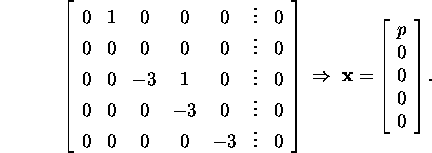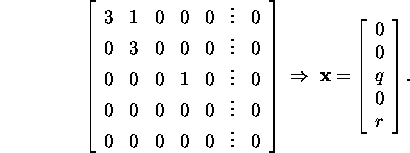It is not sufficient to find the eigenvalues of the matrix to obtain the Jordan form of this matrix.
Example 5.2.1. Let us find the Jordan
matrices J of the matrices
![]()
It is easy to find out that the spectres of ![]() and I are the same,
and I are the same, ![]() Let us find the eigenvectors corresponding
to
Let us find the eigenvectors corresponding
to ![]() :
:




We see that the matrices ![]() and
and ![]() have only one independent eigenvector
and only one Jordan
block corresponding to the eigenvalue
have only one independent eigenvector
and only one Jordan
block corresponding to the eigenvalue
![]() ,
and thus the matrices
,
and thus the matrices ![]() and
and ![]() have the same Jordan
matrix
have the same Jordan
matrix
![]()
The matrix I has two linearly
independent eigenvectors and,
consequently, two Jordan
blocks, and the corresponding Jordan
matrix coincides with the matrix I.
Problem 5.2.1. Verify that the matrix

it corresponds the one-block Jordan
matrix

Example 5.2.2. Let us consider the Jordan
matrix

Let us find the eigenvectors corresponding
to the eigenvalue ![]() of multiplicity 2:
of multiplicity 2:

Therefore, to the eigenvalue
![]() it corresponds one linearly
independent eigenvector
it corresponds one linearly
independent eigenvector
![]() and one Jordan block
and one Jordan block
![]()
Let us find the eigenvectors
corresponding to the eigenvalue
![]() of multiplicity 3:
of multiplicity 3:

Hence to the eigenvalue ![]() it corresponds two linearly
independent eigenvectors
it corresponds two linearly
independent eigenvectors
![]() and
and ![]() and two Jordan blocks
and two Jordan blocks
![]()
and
![]()
The question arises, what conditions mest setisfy the ![]() matrix A to have for the corresponding Jordan
matrix the J given by (5)? How to find the regular matrix X
such that
matrix A to have for the corresponding Jordan
matrix the J given by (5)? How to find the regular matrix X
such that
![]()
The first condition is ![]() but it is not sufficient. The eigenvalues
of the matrix A must be also considered. We express the relation
(6) in the form AX=XJ or
but it is not sufficient. The eigenvalues
of the matrix A must be also considered. We express the relation
(6) in the form AX=XJ or

Having multiplied the matrices, we get the formulas
![]()
and
![]()
From the formulas (7)
and (8) it follows that similarly to the matrix J
the matrix A must have three eigenvectors
![]() and
and ![]() In addition, the matrix A must have two generalized eigenvectors
or two first order flag vectors
In addition, the matrix A must have two generalized eigenvectors
or two first order flag vectors ![]() and
and ![]() It is said that the vector
It is said that the vector ![]() belongs to the chain that begins with the vector
belongs to the chain that begins with the vector ![]() and is defined by the formula (7). This chain determines
the Jordan block J1.
Two first formula of (8) define the second chain consisting
of the vectors
and is defined by the formula (7). This chain determines
the Jordan block J1.
Two first formula of (8) define the second chain consisting
of the vectors ![]() and
and ![]() ,
and this chain, in its turn, defines the Jordan
block J2. The last of the formulas (8)
defines the third chain consisting of the vector
,
and this chain, in its turn, defines the Jordan
block J2. The last of the formulas (8)
defines the third chain consisting of the vector ![]() ,
and this chain, in its turn, defines the Jordan
block J3.
,
and this chain, in its turn, defines the Jordan
block J3.
Proposition 5.2.1.
The fixation of the Jordan
form of the matrix ![]() reduces to the finding of chains. Every chain starts
on the eigenvector of the
matrix A and for every value of the index i=1:n
reduces to the finding of chains. Every chain starts
on the eigenvector of the
matrix A and for every value of the index i=1:n
![]()
The vectors ![]() are the column vectors of the matrix X, and every chain determines
one Jordan block.
are the column vectors of the matrix X, and every chain determines
one Jordan block.